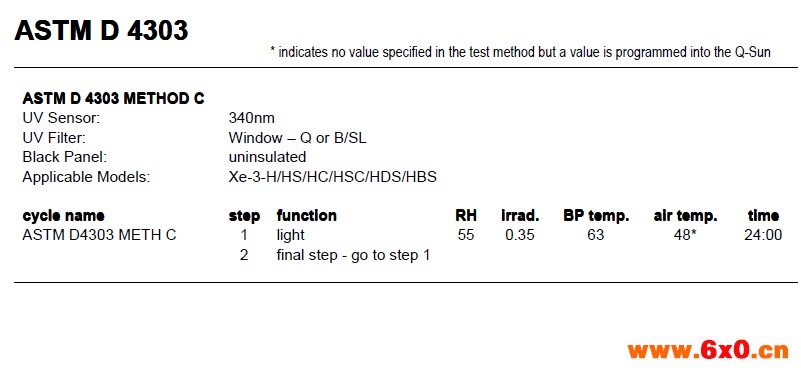本页面标准信息均来源于网络收集,或由参与标准制定的供应商提供,只作为参考使用,为确保测试结果的准确性、节省您的时间,如需ASTM D4303-2016标准详细信息或ASTM D4303-2016具体测试方法,欢迎与我们技术人员联系或给我们留言,我们将为您相关的技术支持。
ASTM D4303-2016标准介绍
艺术材料中使用的着色剂光稳定性的标准测试方法:
描述了4种加速长期室内照明对艺术材料的影响的测试方法。
1.测试方法A-暴露于透过玻璃过滤片的自然光;
2.测试方法B-暴露于日光荧光灯的辐照度;
3.测试方法C-暴露于透过玻璃的模拟日光辐射的Q-SUN氙弧灯;
4.测试方法D-暴露于冷白荧光灯和透过钠钙玻璃片的荧光紫外灯的辐照度。
Q-sun氙灯试验箱ASTM D4303测试方法

ASTM D4303英文版本(节选)
Significance and Use
The retention of chromatic properties by a colorant over a long period of years is essential in a work of art. Accelerated exposure simulates color changes that may reasonably be expected. The producer and the user of artists' materials, therefore, can be apprised of suitable colorants.
Variations in results may be expected between the test methods. Also, some variation may be expected when the same test is repeated. Variations in Methods A and B are due to differences in outdoor conditions that are not accounted for in testing to equivalent radiant exposures. Information on sources of variability and strategies for addressing variability in laboratory accelerated exposure tests is found in Guide G141.
This standard does not cover factors other than lightfastness that can affect the permanence of art materials.
1. Scope
1.1 Four test methods to accelerate the effects of long term indoor illumination on artists' materials are described below. One of the natural daylight methods and one of the xenon-arc methods are used to categorize the lightfastness of colorants.
1.1.1 Test Method A—Exposure in southern Florida to natural daylight filtered through window glass.
1.1.2 Test Method B—Exposure in Arizona to natural daylight filtered through window glass.
1.1.3 Test Method C—Exposure in a non-humidity controlled xenon-arc device simulating daylight filtered through window glass.
1.1.4 Test Method D—Exposure in a humidity controlled xenon-arc device simulating daylight filtered through window glass.
1.2 These test methods are used to approximate the color change that can be expected over time in colorants used in artists' materials exposed indoors to daylight through window glass.
Note 1—The color changes that result from accelerated exposure may not duplicate the results of normal indoor exposure in a home, art gallery, or museum. The relative resistance to change, however, can be established so colored materials can be assigned to categories of relative lightfastness.
Note 2—Users who wish to test colored materials under fluorescent illumination should consult Practice D4674.
1.3 Lightfastness categories are established to which colorants are assigned based on the color difference between specimens before and after exposure.
1.4 Color difference units are calculated by the CIE 1976 L*a*b* color difference equation.
1.5 These test methods apply to colored artists' materials.
1.6 The values stated in SI units are to be regarded as the standard. The values given in parentheses are for information only.
1.7 This standard does not purport to address the safety concerns, if any, associated with its use. It is the responsibility of the user of this standard to establish appropriate safety and health practices and determine the applicability of regulatory limitations prior to use.
2. Referenced documents
ASTM Standards
D2244 Practice for Calculation of Color Tolerances and Color Differences from Instrumentally Measured Color Coordinates
D4302 Specification for Artists Oil, Resin-Oil, and Alkyd Paints
D4674 Practice for Accelerated Testing for Color Stability of Plastics Exposed to Indoor Office Environments
D5067 Specification for Artists Watercolor Paints
D5098 Specification for Artists Acrylic Dispersion Paints
D5724 Specification for Gouache Paints
D6901 Specification for Artists Colored Pencils
E284 Terminology of Appearance
E1347 Test Method for Color and Color-Difference Measurement by Tristimulus Colorimetry
E1348 Test Method for Transmittance and Color by Spectrophotometry Using Hemispherical Geometry
E1349 Test Method for Reflectance Factor and Color by Spectrophotometry Using Bidirectional (45:0 or 0:45) Geometry
G24 Practice for Conducting Exposures to Daylight Filtered Through Glass
G113 Terminology Relating to Natural and Artificial Weathering Tests of Nonmetallic Materials
G141 Guide for Addressing Variability in Exposure Testing of Nonmetallic Materials
G151 Practice for Exposing Nonmetallic Materials in Accelerated Test Devices that Use Laboratory Light Sources
G155 Practice for Operating Xenon Arc Light Apparatus for Exposure of Non-metallic Materials
▼ASTM D4303-2016第三方检测机构
以上标准信息来自互联网搜索整理,如需了解完整的ASTM D4303-2016的信息或ASTM D4303-2016标准解读,欢迎详询。










 QQ交流群
QQ交流群

